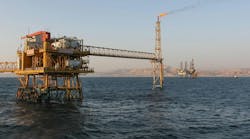ADIPEC 2025: Rockwell SME shares how to navigate the evolving cyber threat landscape in the Middle East
Key Highlights
- The threat landscape is intensifying with politically motivated, state-sponsored cyber attacks targeting offshore energy assets in the Middle East.
- Legacy systems and poor network segmentation are major vulnerabilities, necessitating modernization and layered security strategies.
- Middle East operators are adopting zero-trust architectures and industrial demilitarized zones to safeguard critical infrastructure.
- Real-time monitoring and AI-driven anomaly detection are vital for early threat identification and response in offshore environments.
By Ariana Hurtado, Editor-in-Chief
As digitalization efforts increase across offshore energy operations in the Middle East, the cybersecurity stakes have never been higher. The region’s energy infrastructure faces a complex and evolving risk landscape.
Ahead of the ADIPEC Conference and Exhibition, Offshore chatted with Naman Taldar, regional lead of operational technology (OT) cybersecurity at Rockwell Automation, to explore how operators can navigate this terrain. In this exclusive interview, Taldar shares insights on threat trends, common vulnerabilities and the strategic shift toward zero-trust architectures and real-time monitoring. He also highlights the essential steps for protecting critical offshore assets in one of the world’s most geopolitically sensitive regions.
Offshore: How would you characterize the current cybersecurity threat landscape for offshore energy infrastructure in the Middle East?
Taldar: The cybersecurity threat landscape facing offshore energy infrastructure in the Middle East demands decisive leadership and strategic resilience. Threat volume is escalating, and adversaries are deploying increasingly sophisticated tactics—many of which are politically motivated and state-sponsored. These actors are targeting the energy sector not only for its economic centrality but also for its geopolitical leverage.
As a leader in this space, it’s imperative to recognize that the attack surface is expanding rapidly. Legacy systems, originally built without cybersecurity considerations, are now interfacing with modern digital networks, creating critical vulnerabilities. This convergence of outdated infrastructure and emerging technologies requires a bold modernization agenda.
Nation-state cyber warfare, hacktivist campaigns and advanced persistent threats (APTs) are no longer sporadic—they are systemic. Offshore assets must transition from reactive defense to proactive resilience. That means championing layered security architectures, accelerating digital transformation and embedding cybersecurity into every operational decision.
To safeguard the region’s energy backbone, leaders must drive cross-sector collaboration, invest in threat intelligence and cultivate a culture of cyber vigilance across all levels of the organization.
Offshore: What are the most common vulnerabilities in offshore operational technology (OT) systems, and how can operators proactively address them?
Taldar: The most common vulnerabilities in offshore operational technology systems often stem from the way these environments were originally built. Many of the systems still in use today were installed decades ago, long before cybersecurity was a design consideration. As a result, legacy infrastructure and unpatched software remain a major weakness. These systems were never intended to be connected or exposed to digital threats, and their outdated architecture makes them difficult to secure or update.
Another significant vulnerability is poor network segmentation. Many offshore facilities still operate with flat network structures, meaning that once an attacker gains access, they can move freely across systems without restriction. Proper segmentation, where networks are divided into zones and layers, limits that lateral movement and ensures that a single compromised system does not endanger the entire operation.
A third issue is the lack of real-time monitoring and visibility. Without continuous oversight of data traffic, asset behavior and system performance, threats often go undetected until they have already caused disruption. Effective monitoring through intrusion detection systems and anomaly analysis enables operators to detect attacks as they occur and respond before they escalate.
Finally, weak authentication and access control are persistent problems. In many environments, multiple users share the same credentials or have unrestricted access to sensitive systems. This lack of accountability increases the risk of accidental or deliberate misuse. Implementing role-based access control, enforcing strong authentication practices and maintaining proper audit trails can significantly reduce exposure.
To proactively address these vulnerabilities, operators need to strengthen their cyber hygiene from the ground up. That means modernizing legacy systems where possible, segmenting networks according to best practices, introducing real-time threat detection and response tools, and applying clear access policies. When these measures work together, they create a layered defense that protects offshore operations from both external and internal threats.
Offshore: Can you share examples of how Middle East offshore operators are implementing zero-trust architectures or network segmentation to protect critical assets?
Taldar: Middle East offshore operators are increasingly adopting zero-trust architectures and Purdue Model-based segmentation to secure critical assets.
This involves isolating OT layers from IT networks, enforcing strict cybersecurity policies and creating industrial demilitarized zones that act as buffer zones between IT and OT environments. Within plants, micro-segmentation is being introduced to ensure that if one zone is compromised, other areas can continue to operate safely.
Operators are also using vendor-neutral technologies for visibility and firewall-based segmentation. The regional benchmark for this approach is IEC 62443, which defines security requirements at every level of the control system and has become the de facto standard across the Middle East for OT cybersecurity.
Offshore: What role does real-time monitoring and anomaly detection play in securing offshore facilities, and how is AI being used to enhance these capabilities?
Taldar: Real-time monitoring and anomaly detection are the foundation of any cybersecurity strategy in industrial environments. Offshore operators cannot protect what they cannot see, so continuous visibility into the network and asset behavior is critical.
By deploying intrusion detection systems and threat monitoring tools, operators gain insights into potential attacks in progress, helping them minimize downtime and damage. These systems also help organizations meet regional and international regulatory requirements, such as IEC 62443, DESC (Dubai) and Qatar CERT frameworks.
Artificial intelligence [AI] is now augmenting these capabilities. AI can perform behavioral analysis to identify unusual activity among users, machines or processes, as well as deliver predictive safeguards through pattern recognition and anomaly correlation. In effect, it helps detect and even anticipate threats before they occur, enabling faster response and better resilience.
Offshore: How do you approach cybersecurity risk assessments for offshore assets, especially in complex environments like subsea installations or remote platforms?
Taldar: In high-stakes environments, like offshore platforms and subsea installations, cybersecurity risk assessments must go beyond technical audits; they require a holistic, mission-critical approach that aligns with operational resilience and national energy security.
As a cybersecurity leader, I approach these assessments through three key lenses:
- Operational context first: I begin by embedding cybersecurity within the operational realities of the asset. Subsea systems and remote platforms often operate in isolation, with limited bandwidth, aging control systems and constrained physical access. Understanding these constraints is essential to tailoring realistic, risk-informed controls that don’t disrupt safety or production.
- Threat-driven, intelligence-led assessment: I prioritize threat modeling based on geopolitical context, adversary capabilities and sector-specific attack patterns. In regions like the Middle East, where state-sponsored actors and APTs frequently target energy infrastructure, we must assume a high baseline of threat sophistication. I integrate threat intelligence into every phase of the assessment—from asset discovery to vulnerability prioritization—ensuring our defenses are aligned with real-world adversaries.
- Resilience through defense-in-depth: Legacy systems, air-gapped assumptions and flat networks are common in offshore environments. I advocate for a layered defense strategy that includes network segmentation, secure remote access, anomaly detection and incident response readiness. Where modernization is constrained, I focus on compensating controls and continuous monitoring to close the gap.
- Stakeholder alignment and governance: Cyber risk is not just an IT issue; it’s a board-level concern. I ensure that risk assessments are communicated in business terms, tied to safety, uptime and regulatory exposure. I also drive cross-functional collaboration between IT, OT, HSE and executive leadership to embed cybersecurity into asset life-cycle planning and emergency response protocols.
Offshore: What are the key regulatory or compliance frameworks shaping cybersecurity strategies in the Middle East offshore sector?
Taldar: The Middle East follows a combination of regional and international frameworks.
At the national level:
- The UAE applies the DESC framework;
- Qatar enforces Qatar CERT; [and]
- Saudi Arabia adheres to the NCA OTCC guidelines.
Across the wider region, the IEC 62443 standard has become the primary reference for OT cybersecurity. It provides a structured approach for securing industrial systems, defining security levels and controls at every layer.
In Africa and parts of the Eastern Mediterranean, organizations often align with the NIST Cybersecurity Framework, especially when they are connected to European operators or partners. Together, these frameworks guide operators toward standardized, risk-based approaches to cybersecurity governance.
Offshore: How can offshore operators balance cybersecurity with operational efficiency, especially when integrating legacy systems with modern digital technologies?
Taldar: Balancing security and efficiency start with understanding the current maturity level of the infrastructure. Offshore operators must identify their critical assets crown jewels, assess which systems can be updated or patched, and determine where compensatory controls are needed.
When replacing legacy systems is not immediately feasible, operators can layer controls on top, such as intrusion detection, access restrictions and network segmentation, to reduce exposure while maintaining uptime. Upgrades can then be scheduled strategically during shutdowns or planned maintenance cycles to minimize operational impact.
This risk-based, phased approach allows operators to strengthen cybersecurity without disrupting production, ensuring both safety and performance remain intact.
Offshore: What workforce training or cultural shifts are needed to strengthen cybersecurity awareness and resilience across offshore teams?
Taldar: The biggest challenge in offshore cybersecurity is cultural rather than technical. Most offshore teams consist of automation, electrical or process engineers, not IT or cybersecurity specialists. Many still see cybersecurity as an IT responsibility, when in reality it is a shared responsibility across all functions.
The first step is to build awareness and ownership through practical training. Teams need to understand how simple actions, like opening a malicious link, can compromise the entire operation. Cross-functional collaboration between IT, OT and on-site personnel is crucial.
Ultimately, organizations must foster a mindset where every individual recognizes their role in cybersecurity defense. Human error is still the weakest link, and education is the most effective way to reduce that risk.
Offshore: Looking ahead, what emerging technologies or strategies do you see redefining cybersecurity for offshore energy operations in the next decade?
Taldar: Several emerging technologies are poised to reshape the future of offshore cybersecurity, particularly as the energy industry becomes more digitally interconnected and data-driven.
One of the most significant is artificial intelligence. AI is increasingly being used to predict, rather than simply detect, cyber threats. By analyzing behavior patterns, system performance and network activity, AI systems can identify early warning signs of potential attacks and trigger preventive measures before disruption occurs. This shift from reactive to predictive cybersecurity will become one of the defining characteristics of the next generation of offshore defense.
Another transformative area is edge computing. As offshore operations generate more data from connected equipment and sensors, operators are moving processing power closer to the source of that data. Edge computing allows information to be processed locally, reducing latency and improving reliability, which is critical in remote environments. This approach not only enhances efficiency but also embeds stronger cybersecurity measures directly into the operational layer, ensuring that data remains protected even before it reaches the cloud or control centers.
Autonomous systems and robotics are also playing an increasingly important role. These technologies are being deployed to carry out inspections, maintenance and other high-risk tasks in offshore environments, helping to reduce downtime and improve safety. Many of these modern autonomous platforms are designed with embedded cybersecurity capabilities, meaning protection is built into the system architecture from the start rather than added later.
Together, these advances will enable a more proactive, secure and connected offshore energy ecosystem. The combination of AI-driven prediction, local processing through edge computing and intelligent autonomous systems will transform cybersecurity from a defensive necessity into a strategic enabler of safer, smarter and more resilient offshore operations.
Rockwell Automation will be exhibiting at booth 15140 at the annual ADIPEC Exhibition and Conference taking place this week in Abu Dhabi, UAE.
Offshore is a media partner of ADIPEC 2025.
About the Author
Ariana Hurtado
Editor-in-Chief
With more than a decade of copy editing, project management and journalism experience, Ariana Hurtado is a seasoned managing editor born and raised in the energy capital of the world—Houston, Texas. She currently serves as editor-in-chief of Offshore, overseeing the editorial team, its content and the brand's growth from a digital perspective.
Utilizing her editorial expertise, she manages digital media for the Offshore team. She also helps create and oversee new special industry reports and revolutionizes existing supplements, while also contributing content to Offshore's magazine, newsletters and website as a copy editor and writer.
Prior to her current role, she served as Offshore's editor and director of special reports from April 2022 to December 2024. Before joining Offshore, she served as senior managing editor of publications with Hart Energy. Prior to her nearly nine years with Hart, she worked on the copy desk as a news editor at the Houston Chronicle.
She graduated magna cum laude with a bachelor's degree in journalism from the University of Houston.



